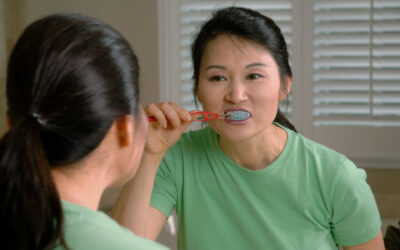There are many different tooth whitening products and procedures available, including whitening toothpastes, over-the-counter gels, rinses, strips, trays, and whitening products obtained from a dentist.
However, whiteners may not correct all types of discoloration. For example, yellowish teeth will probably bleach well, brownish-colored teeth may bleach less well, and grayish-hued teeth may not bleach well at all.
In addition, if you have had bonding or tooth-colored fillings placed in your front teeth, a whitener will not affect the color of these materials, and they may stand out in your newly whitened smile, in which case you might wish to investigate other options, like porcelain veneers or more dental bonding.
According to the American Dental Association, if you are interested in whitening your smile, you should start by speaking with your dentist, who can tell you which whitening procedures would be effective for you.
We’ll briefly go over some of the most common whitening treatments here:
Whitening Toothpastes
All toothpastes help remove surface stains, because they contain mild abrasives. Some whitening toothpastes contain gentle polishing or chemical agents that provide additional stain removal. Whitening toothpastes can help remove surface stains only and do not contain bleach, but can lighten the tooth’s color by about one shade.
Over-the-Counter Whitening Strips and Gels
Whitening gels are clear, peroxide-based gels applied with a small brush directly to the surface of your teeth. Whitening strips are very thin, virtually invisible strips that are coated with a peroxide-based whitening gel applied to the surface of your teeth.
Instructions generally call for twice-a-day application for 14 days, and initial results can be seen in just a few days with final results remaining for about four months.
Whitening Rinses
Among the newest whitening products available are whitening rinses. Like most mouthwashes, they freshen breath and help reduce dental plaque and gum disease. But these products also include ingredients, such as hydrogen peroxide, which whiten teeth. Manufacturers say it may take 12 weeks to see results.
To apply, you just swish them around in your mouth for 60 seconds twice a day before brushing your teeth.
Some experts say that rinses may not be as effective as other over-the-counter whitening products. Because a whitening rinse is only in contact with the teeth for such a short time – just two minutes a day compared to 30 to 60 minutes for many strips – it may have less of an effect.
Tray-Based Tooth Whiteners
Tray-based tooth whitening systems, purchased either over-the-counter or from a dentist, involve filling a mouth guard-like tray with a gel whitening solution which contains a peroxide-bleaching agent. The tray is worn for a period of time, generally a couple of hours a day or every night for two to four weeks (depending on the degree of discoloration and desired level of whitening).
Our office will make a custom tray that holds the bleaching solution against your teeth. It is not uncommon for teeth to become sensitive after bleaching, but this is only temporary and the solutions our office uses cause the least sensitivity. Commercial products purchased over-the-counter sometimes use stronger solutions, so you want to watch for increased sensitivity.
The effects of tray-based bleaching should last a year or more. Periodic retreatment may be needed, but this usually involves simply getting new solution to use in your existing tray, and a much shorter application time than was needed initially.
In-Office Bleaching
This procedure is also called chairside bleaching and usually requires only one office visit. The dentist applies either a protective gel to the gums or a rubber shield to protect the oral soft tissues. A bleaching agent is then applied to the teeth, and a special light may be used.
In general, however, such treatments have been found to be uncomfortable for the patients during the lengthy time required by the process. In addition, color relapse can often occur within two weeks of chairside treatment. For these reasons, our office does not currently offer in-office bleaching.
Drawbacks to Home Bleaching
Please be aware that home tooth bleaching treatments can have significant negative effects.
The side effects that occur most often are a temporary increase in tooth sensitivity and mild irritation of the soft tissues of the mouth, particularly the gums. Tissue irritation most commonly results from an ill-fitting mouthpiece tray rather than the tooth-bleaching agent. Both of these conditions usually are temporary.
However, prolonged exposure to bleaching agents may damage tooth enamel. This is especially the case with home remedy whitening products that contain fruit acids, and brushing with abrasives such as baking soda.
Bleaching is not recommended in children under the age of 16. This is because the pulp chamber, or nerve of the tooth, is enlarged until this age. Tooth whitening could irritate the pulp or cause it to become sensitive.
Tooth whitening is also not recommended for pregnant or lactating women.
Remember: when selecting a whitener or any dental product, be sure to look for the ADA Seal of Acceptance – your assurance that they have met ADA standards of safety and effectiveness.
Here’s a brief video about tooth whitening from the ADA.
If you live in the Fort Smith area and would like to consult with Dr. Staton about tooth whitening, please give us a call at 479-452-1738 or use our Contact Form to make an appointment today!



